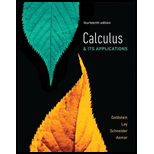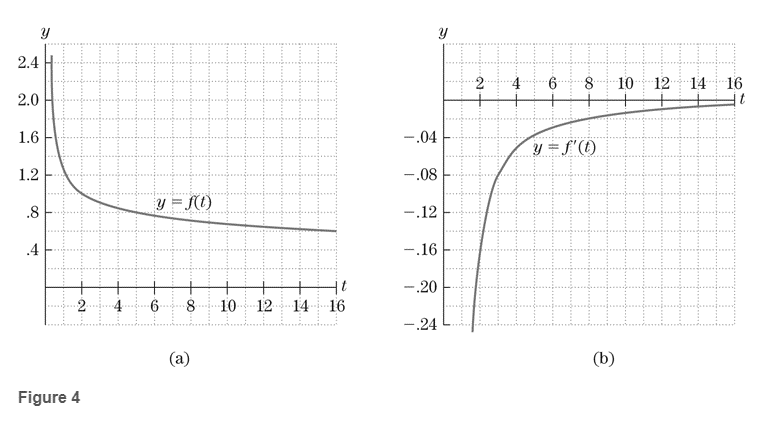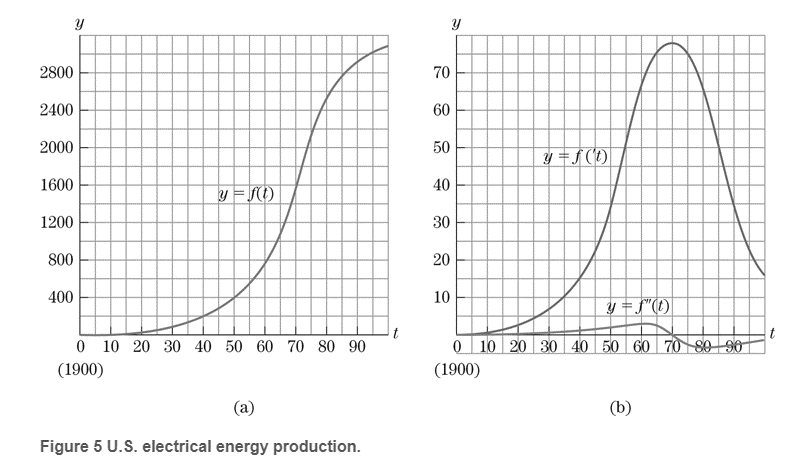
U.S. Electric Energy United States electrical energy production (in trillions of kilowatt-hours) in year
(a) and
a. How much electrical energy was produced in
b. How fast was the energy production rising in
c. When did the energy production reach
d. When was the level of energy production rising at the rate of
e. When was the energy production growing at the greatest rate? What was the level of production at that time?


Want to see the full answer?
Check out a sample textbook solution
Chapter 2 Solutions
Calculus & Its Applications (14th Edition)
- Q2: Find the interval and radius of convergence for the following series: Σ n=1 (-1)η-1 xn narrow_forward8. Evaluate arctan x dx a) xartanx 2 2 In(1 + x²) + C b) xartanx + 1½-3ln(1 + x²) + C c) xartanx + In(1 + x²) + C d) (arctanx)² + C 2 9) Evaluate Inx³ dx 3 a) +C b) ln x² + C c)¾½ (lnx)² d) 3x(lnx − 1) + C - x 10) Determine which integral is obtained when the substitution x = So¹² √1 - x²dx sine is made in the integral πT π π a) √ sin cos e de b) √ cos² de c) c Ꮎ Ꮎ cos² 0 de c) cos e de d) for cos² e de πT 11. Evaluate tan³xdx 1 a) b) c) [1 - In 2] 2 2 c) [1 − In2] d)½½[1+ In 2]arrow_forward12. Evaluate ſ √9-x2 -dx. x2 a) C 9-x2 √9-x2 - x2 b) C - x x arcsin ½-½ c) C + √9 - x² + arcsin x d) C + √9-x2 x2 13. Find the indefinite integral S cos³30 √sin 30 dᎾ . 2√√sin 30 (5+sin²30) √sin 30 (3+sin²30) a) C+ √sin 30(5-sin²30) b) C + c) C + 5 5 5 10 d) C + 2√√sin 30 (3-sin²30) 2√√sin 30 (5-sin²30) e) C + 5 15 14. Find the indefinite integral ( sin³ 4xcos 44xdx. a) C+ (7-5cos24x)cos54x b) C (7-5cos24x)cos54x (7-5cos24x)cos54x - 140 c) C - 120 140 d) C+ (7-5cos24x)cos54x e) C (7-5cos24x)cos54x 4 4 15. Find the indefinite integral S 2x2 dx. ex - a) C+ (x²+2x+2)ex b) C (x² + 2x + 2)e-* d) C2(x²+2x+2)e¯* e) C + 2(x² + 2x + 2)e¯* - c) C2x(x²+2x+2)e¯*arrow_forward
- 4. Which substitution would you use to simplify the following integrand? S a) x = sin b) x = 2 tan 0 c) x = 2 sec 3√√3 3 x3 5. After making the substitution x = = tan 0, the definite integral 2 2 3 a) ៖ ស្លឺ sin s π - dᎾ 16 0 cos20 b) 2/4 10 cos 20 π sin30 6 - dᎾ c) Π 1 cos³0 3 · de 16 0 sin20 1 x²√x²+4 3 (4x²+9)2 π d) cos²8 16 0 sin³0 dx d) x = tan 0 dx simplifies to: de 6. In order to evaluate (tan 5xsec7xdx, which would be the most appropriate strategy? a) Separate a sec²x factor b) Separate a tan²x factor c) Separate a tan xsecx factor 7. Evaluate 3x x+4 - dx 1 a) 3x+41nx + 4 + C b) 31n|x + 4 + C c) 3 ln x + 4+ C d) 3x - 12 In|x + 4| + C x+4arrow_forward1. Abel's Theorem. The goal in this problem is to prove Abel's theorem by following a series of steps (each step must be justified). Theorem 0.1 (Abel's Theorem). If y1 and y2 are solutions of the differential equation y" + p(t) y′ + q(t) y = 0, where p and q are continuous on an open interval, then the Wronskian is given by W (¥1, v2)(t) = c exp(− [p(t) dt), where C is a constant that does not depend on t. Moreover, either W (y1, y2)(t) = 0 for every t in I or W (y1, y2)(t) = 0 for every t in I. 1. (a) From the two equations (which follow from the hypotheses), show that y" + p(t) y₁ + q(t) y₁ = 0 and y½ + p(t) y2 + q(t) y2 = 0, 2. (b) Observe that Hence, conclude that (YY2 - Y1 y2) + P(t) (y₁ Y2 - Y1 Y2) = 0. W'(y1, y2)(t) = yY2 - Y1 y2- W' + p(t) W = 0. 3. (c) Use the result from the previous step to complete the proof of the theorem.arrow_forward2. Observations on the Wronskian. Suppose the functions y₁ and y2 are solutions to the differential equation p(x)y" + q(x)y' + r(x) y = 0 on an open interval I. 1. (a) Prove that if y₁ and y2 both vanish at the same point in I, then y₁ and y2 cannot form a fundamental set of solutions. 2. (b) Prove that if y₁ and y2 both attain a maximum or minimum at the same point in I, then y₁ and Y2 cannot form a fundamental set of solutions. 3. (c) show that the functions & and t² are linearly independent on the interval (−1, 1). Verify that both are solutions to the differential equation t² y″ – 2ty' + 2y = 0. Then justify why this does not contradict Abel's theorem. 4. (d) What can you conclude about the possibility that t and t² are solutions to the differential equation y" + q(x) y′ + r(x)y = 0?arrow_forward
- Question 4 Find an equation of (a) The plane through the point (2, 0, 1) and perpendicular to the line x = y=2-t, z=3+4t. 3t, (b) The plane through the point (3, −2, 8) and parallel to the plane z = x+y. (c) The plane that contains the line x = 1+t, y = 2 − t, z = 4 - 3t and is parallel to the plane 5x + 2y + z = 1. (d) The plane that passes through the point (1,2,3) and contains the line x = 3t, y = 1+t, and z = 2-t. (e) The plane that contains the lines L₁: x = 1 + t, y = 1 − t, z = 2t and L2 : x = 2 − s, y = s, z = 2.arrow_forwardPlease find all values of x.arrow_forward3. Consider the initial value problem 9y" +12y' + 4y = 0, y(0) = a>0: y′(0) = −1. Solve the problem and find the value of a such that the solution of the initial value problem is always positive.arrow_forward
- 5. Euler's equation. Determine the values of a for which all solutions of the equation 5 x²y" + axy' + y = 0 that have the form (A + B log x) x* or Ax¹¹ + Bä” tend to zero as a approaches 0.arrow_forward4. Problem on variable change. The purpose of this problem is to perform an appropriate change of variables in order to reduce the problem to a second-order equation with constant coefficients. ty" + (t² − 1)y'′ + t³y = 0, 0arrow_forward4. Some psychologists contend that the number of facts of a certain type that are remembered after t hours is given by f(t)== 90t 951-90 Find the rate at which the number of facts remembered is changing after 1 hour and after 10 hours. Interpret.arrow_forwardarrow_back_iosSEE MORE QUESTIONSarrow_forward_ios
- Algebra & Trigonometry with Analytic GeometryAlgebraISBN:9781133382119Author:SwokowskiPublisher:Cengage

 Glencoe Algebra 1, Student Edition, 9780079039897...AlgebraISBN:9780079039897Author:CarterPublisher:McGraw Hill
Glencoe Algebra 1, Student Edition, 9780079039897...AlgebraISBN:9780079039897Author:CarterPublisher:McGraw Hill 
 Big Ideas Math A Bridge To Success Algebra 1: Stu...AlgebraISBN:9781680331141Author:HOUGHTON MIFFLIN HARCOURTPublisher:Houghton Mifflin Harcourt
Big Ideas Math A Bridge To Success Algebra 1: Stu...AlgebraISBN:9781680331141Author:HOUGHTON MIFFLIN HARCOURTPublisher:Houghton Mifflin Harcourt





